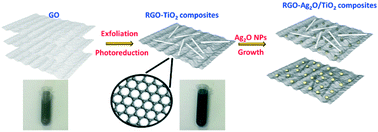当前位置:
X-MOL 学术
›
Catal. Sci. Technol.
›
论文详情
Our official English website, www.x-mol.net, welcomes your
feedback! (Note: you will need to create a separate account there.)
Towards full-spectrum (UV, visible, and near-infrared) photocatalysis: achieving an all-solid-state Z-scheme between Ag2O and TiO2 using reduced graphene oxide as the electron mediator
Catalysis Science & Technology ( IF 4.4 ) Pub Date : 2017-08-18 00:00:00 , DOI: 10.1039/c7cy01349c Xiaolin Hu 1, 2, 3, 4 , Xiang Liu 1, 2, 3, 4 , Jian Tian 1, 2, 3, 4 , Yujie Li 1, 2, 3, 4 , Hongzhi Cui 1, 2, 3, 4
Catalysis Science & Technology ( IF 4.4 ) Pub Date : 2017-08-18 00:00:00 , DOI: 10.1039/c7cy01349c Xiaolin Hu 1, 2, 3, 4 , Xiang Liu 1, 2, 3, 4 , Jian Tian 1, 2, 3, 4 , Yujie Li 1, 2, 3, 4 , Hongzhi Cui 1, 2, 3, 4
Affiliation

|
Making full use of solar energy and achieving high charge separation efficiency are critical factors for the photocatalysis technique. Silver oxide (Ag2O) was used for photocatalysis due to its broad spectrum response. However, the serious photocorrosion and fast carrier recombination of Ag2O have limited its practical applications. In this work, we propose a strategy to suppress its photocorrosion and promote charge separation by the construction of an all-solid-state Z-scheme photocatalytic system for photocatalytic degradation of tetracycline (TC) under UV light, visible light, near-infrared (NIR) light and simulated solar light irradiation, which was composed of electron-mediated reduced graphene oxide (RGO)-enwrapped TiO2 nanobelts (NBs) as UV-responsive photocatalysts and visible/NIR-light-driven Ag2O nanoparticles (NPs). The improved photoactivity and anti-photocorrosion of RGO–Ag2O/TiO2 composites can be attributed to the following: (i) RGO can serve as a charge transmission bridge between Ag2O and TiO2, and the Z-scheme keeps the electrons with high reducing capability in the conduction band (CB) of TiO2 and the holes with high oxidation capability in the valence band (VB) of Ag2O; (ii) Ag2O NPs are well photodeposited on the surface of RGO and increase the visible and NIR light absorption via their narrow band gap (1.15 eV); (iii) the Z-scheme electron transport mechanism induced the accumulation of photoinduced holes in the VB of Ag2O which can protect Ag2O from photocorrosion. The trapping experiments confirmed that ˙O2− and h+ are the main active species in the photocatalytic degradation of TC.
中文翻译:

迈向全光谱(UV,可见光和近红外)光催化:使用还原型氧化石墨烯作为电子介体,在Ag 2 O和TiO 2之间实现全固态Z方案
充分利用太阳能并实现高电荷分离效率是光催化技术的关键因素。氧化银(Ag 2 O)由于具有广谱响应而被用于光催化。然而,Ag 2 O的严重的光腐蚀和快速的载流子重组限制了其实际应用。在这项工作中,我们提出了一种通过构建全固态Z方案光催化体系来抑制其光腐蚀并促进电荷分离的策略,该体系用于在紫外光,可见光,近红外光下对四环素(TC)进行光催化降解。 NIR)光和模拟的太阳光辐照,其由电子介导的还原氧化石墨烯(RGO)包裹的TiO 2组成纳米带(NBs)作为紫外线响应光催化剂和可见/近红外光驱动的Ag 2 O纳米颗粒(NPs)。RGO-Ag 2 O / TiO 2复合材料的光活性和抗光蚀性的改善可归因于以下方面:(i)RGO可以充当Ag 2 O和TiO 2之间的电荷传输桥,并且Z方案可保持TiO 2的导带(CB)具有高还原能力的电子和Ag 2 O的价带(VB)具有高氧化能力的空穴;(ii)Ag 2 O NPs很好地沉积在RGO的表面上,并通过他们的窄带隙(1.15 eV); (iii)Z-方案电子传输机制引起Ag 2 O的VB中光致空穴的积累,其可以保护Ag 2 O免受光腐蚀。捕集实验证实,ö 2 -和H +在TC的光催化降解的主要活性物质。
更新日期:2017-09-19
中文翻译:

迈向全光谱(UV,可见光和近红外)光催化:使用还原型氧化石墨烯作为电子介体,在Ag 2 O和TiO 2之间实现全固态Z方案
充分利用太阳能并实现高电荷分离效率是光催化技术的关键因素。氧化银(Ag 2 O)由于具有广谱响应而被用于光催化。然而,Ag 2 O的严重的光腐蚀和快速的载流子重组限制了其实际应用。在这项工作中,我们提出了一种通过构建全固态Z方案光催化体系来抑制其光腐蚀并促进电荷分离的策略,该体系用于在紫外光,可见光,近红外光下对四环素(TC)进行光催化降解。 NIR)光和模拟的太阳光辐照,其由电子介导的还原氧化石墨烯(RGO)包裹的TiO 2组成纳米带(NBs)作为紫外线响应光催化剂和可见/近红外光驱动的Ag 2 O纳米颗粒(NPs)。RGO-Ag 2 O / TiO 2复合材料的光活性和抗光蚀性的改善可归因于以下方面:(i)RGO可以充当Ag 2 O和TiO 2之间的电荷传输桥,并且Z方案可保持TiO 2的导带(CB)具有高还原能力的电子和Ag 2 O的价带(VB)具有高氧化能力的空穴;(ii)Ag 2 O NPs很好地沉积在RGO的表面上,并通过他们的窄带隙(1.15 eV); (iii)Z-方案电子传输机制引起Ag 2 O的VB中光致空穴的积累,其可以保护Ag 2 O免受光腐蚀。捕集实验证实,ö 2 -和H +在TC的光催化降解的主要活性物质。











































 京公网安备 11010802027423号
京公网安备 11010802027423号